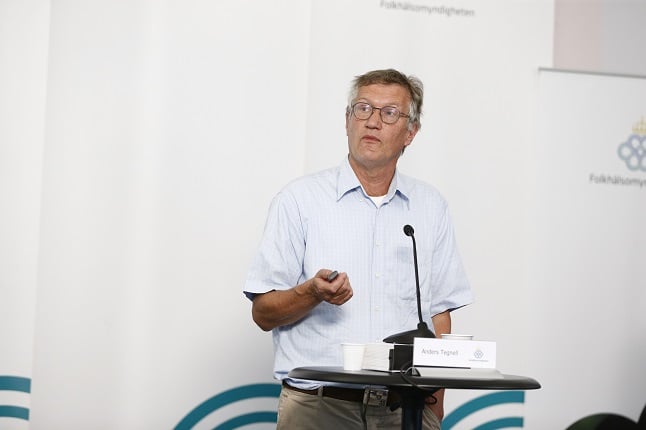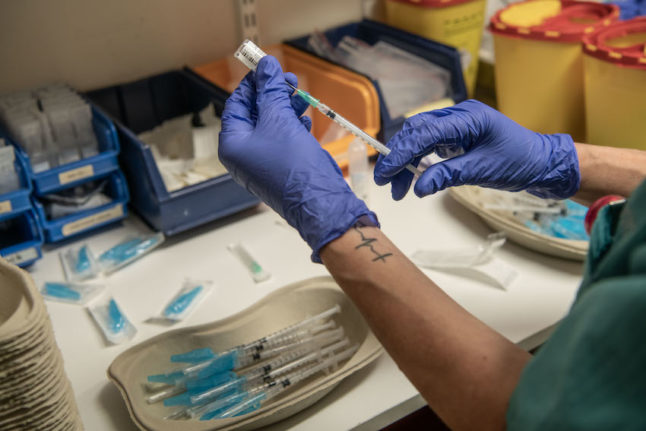Sweden is one of 11 European countries for which the World Health Organisation issued a special warning on Thursday, due to high transmission rate of Covid-19.
The other ten countries were Armenia, Moldova, North Macedonia, Azerbaijan, Kazakhstan, Albania, Bosnia and Herzegovina, Kyrgyzstan, Ukraine and Kosovo.
Pressure on healthcare?
“For weeks I have spoken about the risk of resurgence [of coronavirus] as countries adjust measures,” said WHO's European Director, Dr Hans Henri Kluge.
“In several countries across Europe, this risk has now become a reality – 30 countries/territories have seen increases in new cumulative cases over the past two weeks. In 11 of these countries/territories, accelerated transmission has led to very significant resurgence that if left unchecked will push health systems to the brink once again in Europe.” Sweden was identified as one of these 11.
Speaking on Swedish TV, state epidemiologist Anders Tegnell said that the WHO's classification was “an unfortunate misinterpretation of data”.
“The pressure on the healthcare system has reduced recently and that's a very clear trend that's continuing. It's very unfortunate that people lump Sweden together with countries that earlier have had no problem at all and are now apparently in the start of their epidemic,” Tegnell told STV's Morgonstudion programme.
Asked how serious it was for Sweden to be singled out by the WHO like this, he said: “It's absolutely serious. And right now in this situation where there's a lot of discussion about which countries you can and can't travel to, this type of statement is very unfortunate. You need to have a dialogue and it's important that you don't make hasty decisions and make hasty statements based on individual figures.”
Changes (and obstacles) to testing
Tegnell insisted that Sweden's confirmed case numbers were rising not because the overall situation is getting worse, but because problems in rolling out testing mean that Sweden has only recently significantly expanded its per capita testing rates. Between May 24th and June 14th, Sweden more than doubled its number of weekly diagnostic tests to reach 60,000 tests per week.
The Public Health Agency also urged all regions to make tests available to anyone experiencing the slightest symptoms of the virus; before June testing was limited to staff in key roles and those requiring medical care for their symptoms. Since the WHO says around 80 percent of those infected only suffer mild symptoms, that means the majority of cases wouldn't show up in the statistics, something Swedish authorities have long acknowledged.
 Anders Tegnell speaking at Thursday's press briefing. Photo: Magnus Andersson / TT
Anders Tegnell speaking at Thursday's press briefing. Photo: Magnus Andersson / TT
This late expansion of testing means that Sweden is now seeing an upward trend in the number of confirmed cases, but authorities insist this is down to a greater proportion of these mild cases showing up in the numbers, where previously these patients would have been ineligible for testing.
Tegnell's explanation is backed up by a steady downward trend in the number of people in intensive care units and in hospital wards in general for Covid-19, and a fall in the average daily reported number of deaths.
Not the full picture
But that data doesn't tell the full story, and WHO isn't the only body drawing conclusions from Sweden's growing confirmed case numbers.
The European Centre for Disease Control (ECDC) recently labelled Sweden as one of just two EU countries where the disease had not passed its peak, also based on the number of newly reported cases, although it noted that “increases in testing in Sweden may partly explain this increase”.
Many countries are also using the rate of newly confirmed cases to determine which countries they will accept tourists from, as Europe gradually opens its borders. This has left Swedes, who have long been holders of one of the world's most powerful passports, subject to harsher restrictions and outright entry bans in many EU countries.
And that may not be entirely unreasonable.
The explanation of increased testing makes sense in understanding why confirmed case numbers are higher than in previous weeks, but it doesn't explain why Sweden has a higher rate of cases than its neighbouring countries.
Sweden does still appear to have much wider spread of the virus compared to other European countries, many of which have a similar testing policy.
In the graph below, you can switch between a linear view, where the X-axis goes up in regular intervals, and a logarithmic view, where the units on the X-axis are powers of ten, making it easier to show data with large changes like the spread of a disease. This shows that Sweden's confirmed Covid-19 cases aren't only high compared to previous weeks in Sweden, but also when compared to other European countries — most of which also offer testing to all adults with symptoms.
Looking at deaths per capita — potentially a more reliable measure of the severity of the epidemic, due to the fact most cases are mild and may not be represented in case figures — Sweden's downward curve is apparent, but the figure for recent weeks is still higher than most other European countries.
There are significant differences in how countries record deaths; Sweden includes all registered deaths where the patient tested positive for coronavirus within the previous 30 days, whereas some countries in Europe do not include deaths at home or at elderly care homes in the figures, or only began to do so in recent weeks.
But neither is Sweden's increase in testing a full explanation for why Sweden has more cases and deaths per capita than many of its neighbours.
The WHO's latest comments will likely fuel the ongoing debate about the coronavirus response in Sweden, which never introduced a lockdown and has instead relied on voluntary measures to contain the spread of the virus.
While most data does seem to show that the epidemic is in its downward phase in Sweden, these new comments highlight both the failures in testing and the overall case and death rate, higher than most European neighbours. And it's the case rate which will likely continue to be used as the basis for things like travel restrictions.



 Please whitelist us to continue reading.
Please whitelist us to continue reading.
Member comments